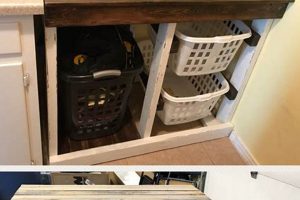A self-assembled workstation designed to remove dust and debris from a work area through downward suction is a valuable asset in many workshops. This type of construction typically involves building a table with a perforated surface connected to a ventilation system, effectively drawing particles away from the user’s breathing zone. An example of this setup would be a woodworking enthusiast constructing a table with a built-in dust collection system to minimize airborne sawdust during sanding or routing operations.
The advantage of creating such a system lies in its potential for cost savings, customization to specific needs, and improved air quality in the workspace. Historically, professional versions of this equipment were expensive and less adaptable. The ability to build a customized unit allows for tailoring the size, suction power, and portability to the individual’s requirements, fostering a safer and more pleasant working environment. This approach enables hobbyists and professionals alike to manage particulate matter effectively.
The following sections will detail the necessary components, construction techniques, and safety considerations for building a personal dust extraction workstation. Included will be guidance on selecting appropriate materials, configuring the ventilation system, and implementing crucial safety features.
Construction Guidelines
The following guidelines provide essential advice for successful construction and optimal performance. Careful adherence to these points will contribute to a safer and more effective dust removal system.
Tip 1: Proper Ventilation System Selection: Choosing the correct ventilation fan is crucial. Consider the cubic feet per minute (CFM) rating to ensure adequate suction for the table’s surface area. A blower that is too weak will not effectively remove dust; a blower that is too powerful may create excessive noise and energy consumption. Consult airflow calculation guides to determine the optimal CFM for your specific requirements.
Tip 2: Material Selection for the Table Surface: Opt for durable and rigid materials for the tabletop, such as MDF (Medium Density Fiberboard) or plywood. Ensure the material is thick enough to withstand the weight of workpieces without sagging. The surface must be smooth and easily cleanable to prevent dust buildup and maintain airflow.
Tip 3: Uniform Perforation Pattern: The pattern of holes on the table’s surface should be consistent and evenly distributed. This ensures uniform airflow across the entire work area. A haphazard pattern will result in uneven suction, leaving some areas more prone to dust accumulation than others. Precise drilling or laser cutting techniques are recommended.
Tip 4: Enclosure Design for Efficient Airflow: The enclosure beneath the tabletop should be designed to efficiently channel air towards the ventilation port. Avoid sharp angles or obstructions that can impede airflow and reduce suction power. Consider a tapered design to concentrate airflow towards the exhaust.
Tip 5: Filtration Considerations: Incorporate a suitable filter between the table surface and the ventilation fan to capture fine particles. This protects the fan motor from damage and prevents recirculation of dust into the environment. Replace or clean the filter regularly to maintain optimal performance.
Tip 6: Sealing and Air Leak Prevention: Ensure all joints and seams in the construction are properly sealed to prevent air leaks. Air leaks reduce the effectiveness of the downdraft system and can introduce unwanted noise. Use caulk or sealant to create airtight seals around the table’s enclosure and ventilation connections.
Tip 7: Grounding and Electrical Safety: When incorporating an electric fan, ensure proper grounding to prevent electrical hazards. Follow all applicable electrical codes and regulations. Consider using a GFCI (Ground Fault Circuit Interrupter) outlet to further enhance safety.
Consistent application of these recommendations will result in a workstation that effectively removes dust and contributes to a cleaner and healthier work environment.
The subsequent sections will address common troubleshooting scenarios and provide guidance on maintaining optimal system performance.
1. Filtration efficiency
Filtration efficiency is paramount when constructing a self-assembled dust extraction workstation. The effectiveness of the filter directly dictates the quality of air expelled, significantly impacting the user’s respiratory health and the cleanliness of the surrounding work environment. Selecting an appropriate filter and maintaining its integrity are therefore critical.
- Filter Media Type and Particle Capture:
The type of filter media determines the size and quantity of particles that the system can effectively capture. High-Efficiency Particulate Air (HEPA) filters, for instance, are capable of trapping 99.97% of particles 0.3 microns in diameter, making them suitable for applications involving fine dust. Less expensive filters, such as those made from spun-bonded polyester, may only capture larger particles, reducing their effectiveness in managing fine dust produced by sanding operations. The correct choice aligns with the specific materials being worked with and the desired level of air quality.
- Airflow Restriction and System Performance:
Filters inherently restrict airflow within the system. More efficient filters, capable of capturing smaller particles, generally present greater resistance to airflow. This resistance can reduce the overall suction power of the downdraft table, potentially compromising its ability to effectively remove dust. Balancing filtration efficiency with airflow capacity is essential. Overly restrictive filters can overload the ventilation fan, leading to premature failure or reduced performance. The system design must account for the filter’s airflow characteristics.
- Filter Maintenance and Longevity:
Regular maintenance, including cleaning or replacement of the filter, is crucial for maintaining optimal filtration efficiency. A clogged filter will significantly reduce airflow and compromise the system’s ability to remove dust. The frequency of filter maintenance depends on the type of filter, the amount of dust generated, and the operating environment. Some filters are washable and reusable, while others are disposable. Failure to maintain the filter can also lead to secondary issues, such as dust buildup within the ventilation system.
- Pre-filtration and Filter Protection:
Implementing a pre-filtration stage can extend the lifespan and effectiveness of the primary filter. A pre-filter, typically a coarse filter media, captures larger particles before they reach the more expensive and efficient main filter. This reduces the load on the primary filter, extending its service life and maintaining airflow. Examples include using a simple mesh screen or a low-cost furnace filter as a pre-filter to capture larger debris from sanding or sawing operations. This strategy offers a cost-effective method to enhance overall system performance.
Integrating a properly selected and maintained filter system into a self-constructed dust extraction workstation is not merely an option, but a necessity for safeguarding respiratory health and creating a cleaner, more productive work environment. Careful consideration of filter media, airflow implications, and maintenance requirements will ensure that the dust extraction system operates effectively and provides long-term value.
2. Airflow Dynamics
Airflow dynamics constitute a critical factor in the performance and effectiveness of a self-constructed dust extraction workstation. The system’s ability to efficiently capture and remove airborne particulate matter relies directly on the principles governing airflow within the table’s structure and surrounding environment. Inadequate consideration of airflow can lead to diminished dust collection, compromising the system’s intended function and potentially posing health risks.
The design of the table’s plenum, the enclosed space beneath the perforated work surface, significantly influences airflow patterns. A well-designed plenum ensures even distribution of suction across the entire work surface, preventing dead zones where dust accumulates. For instance, a plenum with tapered sides can concentrate airflow towards the exhaust port, maximizing suction velocity. Conversely, a poorly designed plenum may create turbulent airflow, reducing suction efficiency and leading to uneven dust collection. The selection of an appropriate fan, characterized by its cubic feet per minute (CFM) rating, is equally important. A fan with insufficient CFM will be unable to generate adequate suction, regardless of the plenum’s design. Balancing plenum design with fan capacity is crucial for achieving optimal airflow.
Understanding and optimizing airflow dynamics is essential for maximizing the effectiveness of a dust extraction workstation. Accurate calculations and careful design are necessary to ensure efficient particle capture and removal. Neglecting these principles can result in a system that fails to adequately protect the user from harmful airborne contaminants. Investing in proper airflow analysis and design contributes directly to a healthier and more productive work environment.
3. Material Durability
Material durability is a significant determinant of the lifespan and operational effectiveness of a self-constructed dust extraction workstation. The selection of robust materials directly influences the table’s ability to withstand the stresses of regular use, including the weight of workpieces, exposure to abrasive particles, and potential impacts. Inadequate material selection can lead to premature failure, necessitating costly repairs or complete replacement. A tabletop constructed from thin, low-density fiberboard, for example, is susceptible to sagging under heavy loads or damage from accidental impacts, compromising the flatness of the work surface and potentially disrupting airflow. Conversely, using materials such as solid hardwood or steel provides greater resistance to wear and tear, ensuring long-term structural integrity.
The components forming the dust collection system also demand durable materials. The enclosure beneath the tabletop, which houses the ventilation fan and filtration system, should be constructed from materials resistant to moisture and particle abrasion. Plywood treated with a moisture-resistant sealant or galvanized steel offers suitable protection. Furthermore, the connections between the table and the ventilation system, including ductwork and fittings, should be made from materials capable of withstanding the negative pressure generated by the fan without collapsing or leaking. Utilizing flexible, reinforced ducting or rigid metal pipes ensures reliable airflow over extended periods.
In summary, material durability constitutes a critical design consideration for a self-built dust extraction workstation. Selecting robust, long-lasting materials minimizes maintenance requirements, reduces the risk of structural failure, and contributes to a safer and more cost-effective working environment. While initial material costs may be higher, the extended service life and reduced downtime associated with durable materials ultimately offer a greater return on investment.
4. Ergonomic design
Ergonomic design profoundly influences the usability and safety of a self-constructed dust extraction workstation. The physical dimensions and layout of the table directly affect the user’s posture, reach, and visual access to the work surface. A table that is too high or too low forces the user to adopt awkward stances, increasing the risk of musculoskeletal strain and fatigue. Similarly, a work surface that is too small restricts movement and can lead to repetitive stress injuries. Consequently, adherence to ergonomic principles is not merely a matter of comfort but a critical factor in preventing long-term health problems. A well-designed workstation facilitates efficient workflow and reduces the physical demands placed on the user.
The placement of controls and accessories further contributes to ergonomic effectiveness. The on/off switch for the ventilation fan should be readily accessible, allowing for quick activation and deactivation without requiring the user to reach across the work surface or bend over. Similarly, integrated lighting should be positioned to minimize glare and shadows, enhancing visibility and reducing eye strain. The inclusion of adjustable height features, while potentially increasing construction complexity, allows the workstation to be customized to individual user needs, promoting optimal posture and reducing the risk of injury. The integration of storage solutions for tools and materials can also minimize unnecessary reaching and bending, further improving ergonomic efficiency.
In conclusion, ergonomic design is an indispensable component of a functional and safe self-built dust extraction workstation. Attention to factors such as table height, work surface area, control placement, and lighting significantly impacts user comfort, productivity, and long-term health. While construction may present challenges, the benefits of an ergonomically sound design far outweigh the added effort, creating a working environment that promotes well-being and minimizes the risk of work-related injuries.
5. Motor power
Motor power represents a critical factor in the functionality of a self-constructed dust extraction workstation. The motor’s capacity directly dictates the volume of air moved through the system, influencing its ability to capture and remove airborne particulate matter effectively. Insufficient motor power results in inadequate suction, rendering the system largely ineffective in controlling dust and posing potential health risks. Proper matching of motor power to the system’s design parameters is therefore paramount.
- Cubic Feet per Minute (CFM) and Suction Velocity
Motor power is directly related to the cubic feet per minute (CFM) of air the system can move. Higher horsepower motors typically generate higher CFM ratings. CFM, in turn, determines the suction velocity at the table’s surface. Insufficient suction velocity allows dust particles to escape capture, negating the system’s intended purpose. Calculation of the required CFM based on the table’s surface area and the type of materials being worked is essential for selecting an appropriately sized motor. For example, fine sanding operations necessitate higher CFM than coarser woodworking tasks.
- Static Pressure and Ductwork Resistance
Motor power must also overcome static pressure, the resistance to airflow caused by ductwork, filters, and other components within the system. Longer duct runs and more restrictive filters increase static pressure, requiring a more powerful motor to maintain adequate airflow. The motor’s static pressure rating indicates its ability to maintain airflow against resistance. Failure to account for static pressure can lead to a significant reduction in CFM, even with a high-horsepower motor. System design must minimize ductwork length and incorporate low-resistance filters to reduce static pressure and optimize motor performance.
- Motor Type and Efficiency
The type of motor used also impacts system performance. Brushless motors, while typically more expensive, offer greater efficiency and longer lifespan compared to brushed motors. Induction motors are another common option, known for their reliability and low maintenance requirements. The motor’s efficiency rating indicates the percentage of electrical power converted into mechanical power. A more efficient motor consumes less electricity for the same level of performance, reducing operating costs and minimizing heat generation. Selecting an appropriate motor type based on these factors is crucial for optimizing system efficiency and longevity.
- Dust Collection Load and Motor Overload Protection
The amount of dust generated by the workstation directly impacts the motor’s load. Over time, accumulated dust can reduce airflow and increase the motor’s operating temperature, potentially leading to premature failure. Implementing a robust filtration system and regularly cleaning the table and ductwork minimizes the dust load on the motor. Additionally, incorporating thermal overload protection into the motor’s wiring prevents overheating and damage in the event of excessive dust buildup or airflow restriction. These measures ensure reliable motor performance and prolong the system’s lifespan.
In conclusion, motor power is inextricably linked to the performance and reliability of a self-constructed dust extraction workstation. Proper selection of motor power, consideration of static pressure, choice of motor type, and implementation of dust collection load management are all essential for creating an effective and long-lasting dust control system. Ignoring these factors compromises the system’s functionality and jeopardizes the user’s health and safety.
6. Cost optimization
Effective cost optimization is integral to the self-construction of a dust extraction workstation. The economic feasibility of building such a unit, compared to purchasing a commercially available model, is a primary motivation for many builders. Cost optimization necessitates a careful evaluation of materials, components, and construction techniques to minimize expenses without compromising functionality or safety. A poorly planned build, neglecting cost considerations, can easily exceed the price of a comparable commercial unit, negating the benefits of the undertaking. This optimization involves balancing initial investment with long-term operating costs, including filter replacement and energy consumption. For instance, choosing less expensive but less durable materials may reduce upfront costs but necessitate more frequent repairs or replacements, ultimately increasing the total cost of ownership. Furthermore, inefficient designs requiring high-wattage ventilation fans contribute to ongoing operational expenses.
Practical application of cost optimization principles involves several key considerations. Sourcing materials from local suppliers or repurposing existing components can significantly reduce expenses. For example, using reclaimed wood for the table’s frame or salvaging a ventilation fan from a discarded appliance can lower material costs. However, careful inspection of salvaged components is crucial to ensure their safety and functionality. A cost-benefit analysis of different filtration systems is also essential. HEPA filters offer superior filtration efficiency but are typically more expensive than standard furnace filters. Determining the necessary level of filtration based on the specific application and balancing that with budget constraints is a key element of cost optimization. Careful design planning to minimize material waste and streamline construction processes can further contribute to cost savings. Leveraging online resources and collaborating with fellow builders can provide valuable insights and alternative solutions for reducing expenses.
In summary, cost optimization is not simply about minimizing initial expenses but involves a holistic assessment of material selection, design efficiency, and long-term operational costs. While the primary driver for self-construction is often cost savings, neglecting quality and safety to achieve a lower price point can undermine the project’s purpose. A balanced approach that prioritizes functionality and durability within a reasonable budget yields the most effective dust extraction workstation. The challenge lies in making informed decisions that optimize value and ensure the finished product meets both performance and economic requirements.
diy downdraft table Frequently Asked Questions
This section addresses common inquiries and misconceptions regarding the construction and application of self-built dust extraction workstations, offering clear and informative answers to guide prospective builders.
Question 1: Does a self-built dust extraction workstation offer sufficient performance compared to commercially manufactured units?
A properly designed and constructed unit can achieve comparable performance to commercial models, provided careful attention is given to airflow dynamics, motor power, and filtration efficiency. However, achieving optimal performance requires a thorough understanding of these factors and meticulous execution.
Question 2: What are the primary safety concerns associated with constructing a dust extraction workstation?
Electrical safety, including proper grounding and overload protection, is paramount. Additionally, ensuring adequate ventilation to prevent the recirculation of fine particles and selecting non-toxic materials for construction are crucial for safeguarding user health.
Question 3: Is specialized expertise required to build a functional dust extraction workstation?
While advanced engineering knowledge is not essential, a basic understanding of woodworking or metalworking techniques, electrical wiring, and ventilation principles is beneficial. Numerous online resources and tutorials can provide guidance for novice builders.
Question 4: What is the optimal filter type for a self-built dust extraction workstation?
The appropriate filter type depends on the type of materials being processed. HEPA filters are recommended for capturing fine dust, while coarser filters may suffice for larger particles. Regular filter maintenance is crucial for maintaining optimal performance.
Question 5: Can a self-built dust extraction workstation be effectively used for all types of dust-generating activities?
The effectiveness of a self-built unit varies depending on the nature of the dust-generating activity and the design of the workstation. Activities producing large volumes of fine dust may require a more powerful system and more frequent filter maintenance.
Question 6: What are the legal or regulatory considerations associated with building and using a dust extraction workstation in a home or commercial setting?
Local building codes and regulations may impose restrictions on ventilation systems and electrical installations. Adherence to these codes is essential for ensuring safety and avoiding potential legal issues.
These answers provide a foundation for understanding the key aspects of constructing a dust extraction workstation. Further research and careful planning are recommended before embarking on such a project.
The following section provides guidance on troubleshooting common issues encountered during the construction and operation of a DIY dust extraction workstation.
DIY Downdraft Table
The preceding exploration of “diy downdraft table” construction has underscored the importance of informed design, careful material selection, and adherence to safety protocols. Success hinges on a thorough understanding of airflow dynamics, filtration efficiency, and motor power considerations. Furthermore, cost optimization should not supersede performance and safety requirements. A well-executed unit offers a viable alternative to commercial offerings, providing a customized solution for dust management.
The construction of a dust extraction workstation presents a tangible opportunity to improve workplace air quality and mitigate potential health hazards. Diligent application of the principles outlined herein will contribute to a safer and more productive work environment. Continued research and refinement of these techniques will further enhance the accessibility and effectiveness of self-built dust control solutions.







